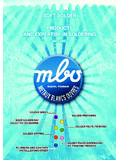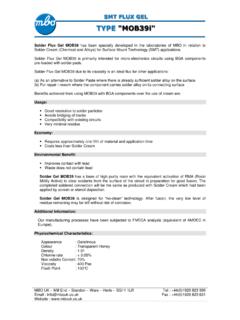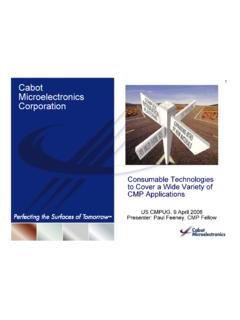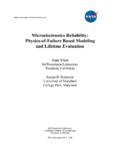Transcription of European Microelectronics and Packaging Symposium
1 European Microelectronics and Packaging SymposiumPrague 16th to 18th June 2004, Czech RepublicTHERMAL conductivity OF MOLTEN LEAD FREE SOLDERSJAROMIR BILEK, JOHN ATKINSON, WILLIAM WAKEHAMU niversity of Southampton, School of Engineering Sciences, Thick Film Unit,Highfield, SO17 1BJ, Southampton, United KingdomE-mail: increasing influence of computational modelling in all technologicalprocesses generates an increased demand for accurate values of the physicalproperties of the materials involved, which are used as fundamental inputsfor every the production of electronic circuits, a thorough knowledge of thethermal conductivity of molten solders can result in a better controlledsoldering process.
2 As a result, this information can be used for setting theoptimum soldering profile and thereby lead to improvement in the qualitycontrol of the solder paper describes the principles of the experimental technique employedfor the measurement of the thermal conductivity of molten solders anddescribes the essential features of the instrumentation. The values of thethermal conductivity of different lead and lead-free solder compositions,measured at various temperatures and temperature profiles, are comparedand briefly : Thermal conductivity , molten solder, FE the development of computational software, most of the modern fabricationprocesses are modelled mathematically before they are implemented in production.
3 Inalmost every production process, computation is being used to predict the behaviour ofthe components and materials during manufacturing. The importance of such modellingincreases with decreases of the dimensions of components and amounts of materials usedand with increasing integration. For meaningful modelling, the material properties mustbe very accurately defined at specific conditions and for every temperature at which thematerial is used or a component mounted. However, without knowing the exactmechanical and thermal properties, the mathematical modelling cannot result in accuratedesign and process solutions.
4 The thermal conductivity is the most important thermalproperty involved in models of thermal expansion and heat transfer phenomena. Forelectronic production, soldering and solder solidification belong to the most critical partsof the fabrication process and therefore this paper focuses on the measurement of thethermal conductivity of molten a new lead-free policy was introduced in all industries [1] and particularly inelectronics production, the research and development of lead-free soldering materials andprocesses have become an important issue.
5 Within the last few years, several new lead-free compositions have been introduced, investigated, and main goal of this paper is to investigate both lead and lead free solders andobserve their thermal conductivity in the liquid phase throughout a range of temperaturesabove the melting point. Knowing accurate thermal conductivity values for molten soldercan significantly help to improve the fabrication process of any electronic device thatmakes use of technique with accuracy within the range 2% has been developed in the lastdecade [2] and an instrument has been designed to measure the thermal conductivity ofmolten metals.
6 This same instrument is also used for the current hot wire methodBecause the main difficulty in performing accurate measurements of the thermalconductivity of fluids lies in the isolation of the conduction process from othermechanisms of heat transfer, it is necessary to employed transient methods. Currently themost accurate transient technique is that based upon a transient hot wire method. Thesuccess of transient techniques is based on the fact that the characteristic time for theacceleration of the fluid by buoyancy forces is much longer than the propagation time ofa temperature wave originated by a strong and localised temperature gradient.
7 Thetransient hot wire technique is an absolute technique and instruments based on itsprinciple are considered capable of providing the highest accuracy possible at present[3].The basic concept of the method is that a voltage step is applied to a hot-wire ,which is immersed in the fluid, and the resistance of the wire (or the voltage across it) ismonitored as a function of time. As the wire is being heated up and its resistance isincreasing with temperature, the voltage also increases. From the changes of voltage withrespect to time, transient resistance changes and the heat flux within the fluid can becalculated.
8 Assuming that an isotropic fluid has a temperature independent thermalconductivity, density and heat capacity over small temperature ranges, a fundamentalequation of all transient experimental methods for the measurement of the thermalconductivity can be written [3, 4]TtTCP2 (1)where is density [kg/m3], Cp is specific heat capacity [J/kg K], T is temperature[K], t is time [s] and is thermal conductivity [W/m K]. Eq. (1) also assumes that there isno contribution of radiative transport in the heat solution of the heat transport Eq. (1) for the transient hot wire method can bederived.
9 It defines the temperature rise of the wire which is immersed directly in the fluidand is given by erCtqTP204ln4(2)where q is the heat flux per unit length [W/m], r0 is the radius of the hot wire [m], is Euler s constant ( ). In its basic form, Eq. (2) indicates that the thermal conductivity of a materialsurrounding the wire can be derived from the slope of the line relating temperature rise tothe logarithm of time. For the circumstances of interest here we must separate the moltenmetal test fluid from the metallic wire by an electrically insulating material so that Eq.
10 (2)cannot be used directly for the evaluation of the thermal conductivity of the moltenmetals, although the basic dependence on the property remains intact. Instead, weemploy a finite-element model of the conduction process to replace Eq. (1) and itssolution in this more complicated procedureThe sensor was originally designed and tested during a previous project [2] and isillustrated in Figure 1. The conductive lines are thick-film printed on unfired aluminatapes of thickness mm. The pure platinum wire (Hot Wire) is placed andsandwiched between two pieces of alumina tape to ensure electrical isolation from themelt.






